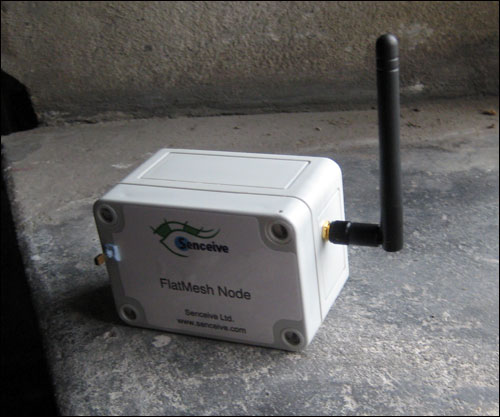After completing a two-year project involving the use of an active RFID mesh network to track conditions that could degrade its stone walls and artwork, the Tower of London continues to utilize the technology to track the environmental cycles of ambient and surface temperatures, as well as humidity, at two towers. This information could then be compared against the conditions of the tower walls and a painting located within the stone structure. The system, known as FlatMesh and provided by Senceive, was put into place in 2009 as part of a research project that the fortress’ caretaker initiated, seeking wireless solutions for environmental monitoring in areas in which thick walls can obstruct transmissions.
The Tower of London, comprising several buildings, towers, museums and historic collections in central London, is one of five historic sites managed by Historic Royal Palaces, an independent charity. Much of the fortress, like many castles in the United Kingdom, was built using Reigate sandstone, a building material commonly used during the medieval period. The stone is highly absorbent, and can thus pull in moisture from the air. If the temperature fluctuates, that moisture can freeze or expand, causing damage from within the structure. For that reason, much of the Reigate stone in British castles has been replaced over the years; however, the upper chamber of the Tower of London’s Wakefield Tower still contains its original Reigate stone walls—as much as 1 meter (3.3 feet) in thickness—and Historic Royal Palaces aims to preserve it. To do so, the group must monitor the conditions around the walls, says Constantina Vlachou, Historic Royal Palaces’ senior conservation scientist.

To respond to changing conditions, the organization can utilize dehumidifiers, heaters or coolers, adjusted according to the needs of the stone or artwork.
In addition to managing the Tower of London, Historic Royal Palaces also oversees Hampton Court Palace, the Banqueting House, Kensington Palace and Kew Palace. All five sites employ wireless sensors, provided by a variety of companies, and installed in areas of concern that transmit data to Wi-Fi access points, thereby allowing a real-time view into the sites’ conditions. The Tower of London is unique, however, due to the 1-meter thickness of many of its walls. Therefore, Historic Royal Palaces reached out to Senceive, which provides a wireless mesh-network system used for rail, construction and architectural monitoring. A large percentage of the company’s work is focused on railways, says Simon Maddison, Senceive’s chief operating officer, but the firm also provides what it calls Heritage Intelligence—a system designed for monitoring environments within castles and other historic landmarks.
“It’s a rather specialized market,” Maddison explains, “but the principles of monitoring [all] structures and architecture are relatively similar.”
Two years ago, the Tower of London installed a total of 20 Senceive sensor nodes compliant with the 802.15.4 (Wi-Fi) standard, four of which acted as repeaters to cover the 70 meters (230 feet) of open space between Wakefield Tower and Byward Tower. The other 16 nodes, divided between the two towers, were placed on windowsills and other level spaces out of the reach of visiting tourists, in order to track both ambient and surface temperatures, as well as humidity, within the two spaces. Of greatest concern in Byward Tower is not the walls, Vlachou says, but rather the conditions around a particular painting on one wall, which dates back to the 1390s and depicts the Crucifixion of Jesus Christ. “This is a very important painting for us,” she states. In this case, Historic Royal Palaces is focused on tracking the light conditions, temperature and humidity within the room, to protect the painting’s quality. The artwork itself is off-limits to visitors, due to its fragility.
The nodes in the Byward Tower come equipped with sensors to detect light, temperature and humidity, all of which store sensory data in real time, and then transmit that information, along with their own unique ID numbers. Other nodes within the vicinity—up to 80 meters (262 feet) away in an open environment—capture those 2.4 GHz transmissions and forward them along to other nodes, thereby creating a mesh network. A solar-powered gateway device then captures data from all of the nodes, and transmits that information to Senceive’s Internet-based server via a GPRS signal.
Historical Royal Palaces’ staff can log onto the site to view a map of the fortress, as well as sensor data specific to the areas in which the nodes were placed, and can also create analyses, such as trends regarding environmental conditions in each area throughout a given day, month or year. In fact, Vlachou says, the data is still being accumulated and analyzed for a full understanding of such trends, as well as the effects those conditions have on the stone walls and the painting. All 20 nodes installed for the two-year project currently remain in use, she notes, and continue to acquire sensor data.
Senceive also installed sensor nodes at the Tower of London’s archives building, which stores 20,000 drawings and photographs of architectural sketches of the five palaces. Here, the items are stored in an underground vault; however, the wireless transmission function was not enabled, since the system could not transmit data through the vault walls. Instead, the sensors functioned as data loggers, storing light, temperature and humidity levels. Because the air was determined to be at a good condition for preserving documents, the sensors were removed in early 2011, after one month of use.
In the future, Vlachou says, Historical Royal Palaces may opt to install the system to track conditions around a tapestry location on exhibit at Hampton Court. However, she notes, no specific plans have yet been determined.


